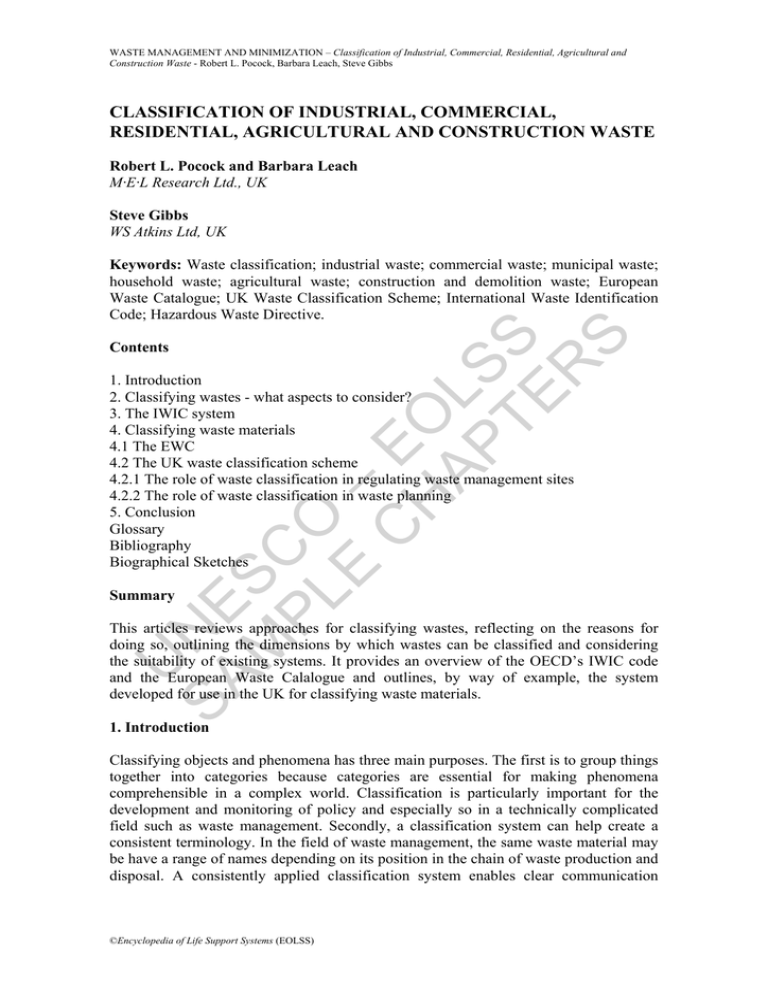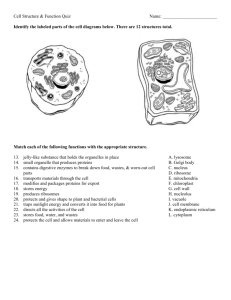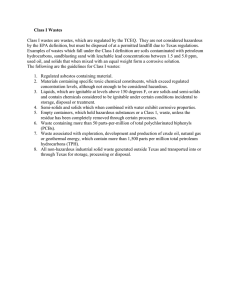Classification of Industrial, Commercial, Residential
advertisement

WASTE MANAGEMENT AND MINIMIZATION – Classification of Industrial, Commercial, Residential, Agricultural and Construction Waste - Robert L. Pocock, Barbara Leach, Steve Gibbs CLASSIFICATION OF INDUSTRIAL, COMMERCIAL, RESIDENTIAL, AGRICULTURAL AND CONSTRUCTION WASTE Robert L. Pocock and Barbara Leach M·E·L Research Ltd., UK Steve Gibbs WS Atkins Ltd, UK U SA NE M SC PL O E – C EO H AP LS TE S R S Keywords: Waste classification; industrial waste; commercial waste; municipal waste; household waste; agricultural waste; construction and demolition waste; European Waste Catalogue; UK Waste Classification Scheme; International Waste Identification Code; Hazardous Waste Directive. Contents 1. Introduction 2. Classifying wastes - what aspects to consider? 3. The IWIC system 4. Classifying waste materials 4.1 The EWC 4.2 The UK waste classification scheme 4.2.1 The role of waste classification in regulating waste management sites 4.2.2 The role of waste classification in waste planning 5. Conclusion Glossary Bibliography Biographical Sketches Summary This articles reviews approaches for classifying wastes, reflecting on the reasons for doing so, outlining the dimensions by which wastes can be classified and considering the suitability of existing systems. It provides an overview of the OECD’s IWIC code and the European Waste Calalogue and outlines, by way of example, the system developed for use in the UK for classifying waste materials. 1. Introduction Classifying objects and phenomena has three main purposes. The first is to group things together into categories because categories are essential for making phenomena comprehensible in a complex world. Classification is particularly important for the development and monitoring of policy and especially so in a technically complicated field such as waste management. Secondly, a classification system can help create a consistent terminology. In the field of waste management, the same waste material may be have a range of names depending on its position in the chain of waste production and disposal. A consistently applied classification system enables clear communication ©Encyclopedia of Life Support Systems (EOLSS) WASTE MANAGEMENT AND MINIMIZATION – Classification of Industrial, Commercial, Residential, Agricultural and Construction Waste - Robert L. Pocock, Barbara Leach, Steve Gibbs between waste producers, waste transporters and the ultimate disposal or treatment site, reducing the chances of accidents occurring. Thirdly, the development of a classification system enables systematic, hierarchically-based codification, essential for efficient data collection, aggregation and reporting. 2. Classifying waste - what aspects to consider? The wide range of dimensions which might be used as the basis of a waste classification system can be illustrated by taking an example of a public official charged with increasing the quantity of waste recycled within a certain geographical area. In order to make sensible plans, the official would want to know as much as possible about the waste within his jurisdiction, including: • • • • • • • U SA NE M SC PL O E – C EO H AP LS TE S R S What waste materials are being produced (e.g. Paper, sulphuric acid) The geographical area of origin (e.g. West midlands of england) Whether the waste has a specific legal designation (e.g. ‘packaging’, ‘hazardous’) Whether the waste has dangerous properties (e.g. Flammable or corrosive) The physical form of the waste (e.g. Solid or sludge) The broad source of the waste (e.g. Households, industry, commerce) The specific type of economic activity that generates the waste (e.g. Manufacture of chemicals) • The types of processes within activities responsible for the producing the waste (e.g. Cleaning of machinery) • The geographical area of destination (e.g. Greater manchester) • The disposal or treatment method used (e.g. landfill) These are all dimensions by which wastes could be classified. However, to try to devise a system incorporating all these dimensions would result in considerable complexity and a vast number of individual codes. A more sensible approach is to classify wastes according to each dimension using separate systems and combine them within the chosen data collection method or regulatory form. This kind of modular approach is taken by the OECD’s International Waste Identification Code (IWIC) system. 3. The IWIC system The long IWIC code consists of seven components: 1. 2. 3. 4. 5. 6. 7. Reason why materials are intended for disposal/recycling (e.g. off-specification residues) Q1-Q16 Disposal/recovery operation (e.g. Incineration on land) D1-D16/R1-R15 Physical form (L-Liquid, P-Sludges, S-Solids and powders, G-Gases) Generic type (e.g. waste pharmaceuticals, drugs and medicines) 1-40 prefixed by physical form code Constituents of potentially hazardous wastes (e.g. vanadium compounds) C1-C51 List of hazardous characteristics (e.g. explosive) H1-H12 Activities which may generate potentially hazardous wastes (e.g. drink industry) A100-A950 ©Encyclopedia of Life Support Systems (EOLSS) WASTE MANAGEMENT AND MINIMIZATION – Classification of Industrial, Commercial, Residential, Agricultural and Construction Waste - Robert L. Pocock, Barbara Leach, Steve Gibbs The resulting code takes the form Q __ // D or R __ // L, P, S or G __ // C __ // H__ // A__ . U SA NE M SC PL O E – C EO H AP LS TE S R S However, the system is designed principally for classifying hazardous waste and more comprehensive component codes are required for classifying other types of waste. Waste-generating activity, for example, is more comprehensively dealt with by NACE Revision 1 than by the A codes of IWIC. Figure 1: Desirable dimensions of a waste classification system Dimension Classification system Properties H codes from IWIC(These correspond to the hazard classification system included in the United Nations Recommendation on the Transport of Dangerous Goods (ST/SG/AC.10/1Rev.5 1988) and have been used in Europe in the Hazardous Waste Directive (91/689/EEC).) Legal designation Use legal definitions Activity of origin NACE Rev 1(In the UK the system is known as the Standard Industrial Classification (or SIC) and was revised in 1992 so as to be directly comparable with NACE.) Disposal/treatment method D and R codes from IWIC(Used by the UN and OECD as part of the Basel Convention on transfrontier shipments of waste and included as annexes in the EU Waste Framework Directive (91/156/EEC). However, the system is not suitable for all uses as it excludes, for example, reuse of waste on the site of production.) Physical form L, P, S and G codes from IWIC Geographical area of origin and destination NUTS(Abbreviation for the Nomenclature of Units for Terrestrial Statistics and is produced by Eurostat, the European Commission’s statistical service.) ©Encyclopedia of Life Support Systems (EOLSS) WASTE MANAGEMENT AND MINIMIZATION – Classification of Industrial, Commercial, Residential, Agricultural and Construction Waste - Robert L. Pocock, Barbara Leach, Steve Gibbs Table 1: Dimensions describing wastes and the corresponding classification systems For most of the dimensions suggested above as being important for describing wastes, there is one obvious system to use, as shown in the table 1 below: There is currently no system for classifying the processes which result in waste production in any more detail than the industry of origin. The most contested dimension is the classification of waste materials, and this is the subject of the remainder of this article. 4. Classifying waste materials U SA NE M SC PL O E – C EO H AP LS TE S R S If a classification of waste materials is intended to form part of a modular system, such as IWIC, it should as a matter of principle avoid all references to the other dimensions of the system and concentrate solely on the waste material. This is the main problem with the European Waste Catalogue (EWC), Europe’s standard system for classifying waste materials. 4.1 The EWC The EWC resulted from amendments made in 1991 to the Waste Framework Directive which required the preparation of a list of wastes belonging to the categories in Annex 1 (the OECD Q codes). The final version was published in 1994 (O.J. L5/15 7/1/94). The list was intended to “improve the efficiency of waste management activities” and form the basis for all European statistics on waste. Its main headings are: 01 00 00 02 00 00 03 00 00 04 00 00 05 00 00 06 00 00 07 00 00 08 00 00 09 00 00 10 00 00 11 00 00 12 00 00 13 00 00 14 00 00 15 00 00 Waste resulting from exploration, mining, dressing and further treatment of minerals and quarrying Waste from agriculture, horticulture, hunting, fishing and aquaculture primary production , food preparation and processing Wastes from wood processing and the production of paper, cardboard, pulp, panels and furniture Wastes from the leather and textile industries Wastes from petroleum refining, natural gas purification and pyrolytic treatment of coal Wastes from inorganic chemical processes Wastes from organic chemical processes Wastes from the manufacture, formulation, supply and use of printing inks Wastes from the photographic industry Inorganic wastes from thermal processes Inorganic waste with metals from metal treatment and the coating of metals Wastes from shaping and surface treatment of metals and plastics Oil wastes (except edible oils, 05 00 00 and 12 00 00) Wastes from organic substances employed as solvents (except 07 00 00 and 08 00 00) Packaging; absorbents, wiping cloths, filter materials and protective ©Encyclopedia of Life Support Systems (EOLSS) WASTE MANAGEMENT AND MINIMIZATION – Classification of Industrial, Commercial, Residential, Agricultural and Construction Waste - Robert L. Pocock, Barbara Leach, Steve Gibbs clothing not otherwise specified Waste not otherwise specified in the catalogue Construction and demolition waste (including road construction) Wastes from human or animal health care and/or related research (excluding kitchen or restaurant wastes which do not arise from immediate health care) Wastes from waste treatment facilities, off-site waste water treatment plants and the water industry Municipal wastes and similar commercial, industrial and institutional wastes including separately collected fractions 16 00 00 17 00 00 18 00 00 19 00 00 20 00 00 U SA NE M SC PL O E – C EO H AP LS TE S R S Research in the UK on the application of the EWC showed that for regulatory purposes it lacked information on pollution potential of the waste and that for data collection and reporting purposes most waste had to be classified as ‘not otherwise specified’, that chemical wastes which arose in relatively small quantities were over-specified while municipal wastes which arose in large quantities were not included in sufficient detail. More fundamentally, its lack of a consistent hierarchical structure and rationale was felt to compromise its usefulness. Some of the EWC categories refer to activity of origin (e.g. 02 04 00 wastes from sugar processing), some to process of origin (e.g. 02 04 01 soil from cleaning and washing beat), some to the physical form of the waste (e.g. 02 04 03 sludges from on-site effluent treatment), some to the main material (e.g. 03 03 01 bark), some to objects (e.g. 09 01 09 single use cameras with batteries) and some to contaminants (e.g. 05 03 01 spent catalysts containing precious metals). This confusion of activities, processes, materials, contaminants and physical forms makes the system unhelpful both for regulation and data reporting. More recently, a substance aggregation of the EWC (EWC(SA)) has been produced to deal with some of these problems although it has carried forward some of the original problems with the EWC. - TO ACCESS ALL THE 12 PAGES OF THIS CHAPTER, Visit: http://www.eolss.net/Eolss-sampleAllChapter.aspx Bibliography Acer Environmental (1993) Provision of a Classification Scheme for UK Wastes Bristol: Environment Agency (DoE Report CWM066/93) [Assessment of the applicability of the EWC to the UK situation] Environment Canada (1993) Export and Import of Hazardous Waste Regulations: User’s Guide to Hazardous Waste Classification Ottawa: Environment Canada (www.ec.gc.ca/tmd/engclass.htm and www.ec.gc.ca/tmd/tablesen.htm) [Includes details of the IWIC system] ©Encyclopedia of Life Support Systems (EOLSS) WASTE MANAGEMENT AND MINIMIZATION – Classification of Industrial, Commercial, Residential, Agricultural and Construction Waste - Robert L. Pocock, Barbara Leach, Steve Gibbs Office for National Statistics (1997) UK Standard Industrial Classification of Economic Activities 1992 (Incorporating New Subclasses Devised Since the 1992 Edition) London: The Stationery Office [Classification system for types of economic activity, compatible with NACE Rev 1] Biographical Sketches Robert Pocock is an environmental scientists by training and the Chief Executive of M·E·L Research, a company which specialises in providing advice to government on waste information and policy. He has been at the forefront of developments in analysing the composition of waste in the UK and chairs an Institute of Wastes Management group on healthcare waste. U SA NE M SC PL O E – C EO H AP LS TE S R S Barbara Leach is M·E·L Research’s Principal Researcher in waste information and policy. Having recently completed her doctorate on waste management policy instruments, she was centrally involved in the development of the UK waste classification scheme. She has advised the Environment Agency in England and Wales on the applicability of the scheme for waste planning functions, and speaks and writes regularly on issues related to waste planning, policy and information. Steve Gibbs has 27 years experience in wastes management, comprising 17 years as a regulator and 10 years in consultancy. In 1973, he was responsible for regulating the UK Deposit of Poisonous Wastes Act 1972, and went on to manage both site permitting and the regulation of hazardous wastes shipments. In 1990 he moved to consultancy, and is presently a Principal Consultant with WS Atkins Consultants Ltd. He has worked on a number of policy advice projects for the UK government, including several in cooperation with Barbara Leach and Bob Pocock. These include the preparation of the draft UK Waste Classification Scheme, on which he has been working since 1993. He contributed to the Environment Agency’s Technical Guidance on Special Wastes, and most recently has been assisting the Agency with European negotiations on waste acceptance criteria for the different classes of landfill under the Landfill Directive. ©Encyclopedia of Life Support Systems (EOLSS)






